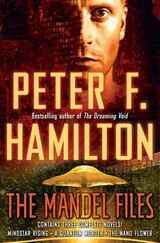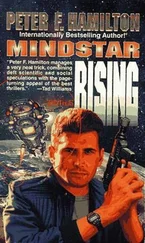Sid gave her his best insincere smile. “Of course.”
“So how is O’Rouke?” Aldred asked as they walked along the corridors to the exam room.
“I believe he mentioned something about getting a result.”
Aldred snorted in sour amusement. “My family wants a certainty here, Detective. We’re prepared to wait for that. Don’t cut corners on our account.”
“With the funding you’ve made available, I won’t have to.”
The corpse was resting on a surgical-style table in the middle of the exam room. Directly above him, long segmented metal arms were attached to the ceiling around the bright lighting circle, each ending in a different kind of sensor. Around them were the holographic cameras to record the procedure. Screens made up one wall, while small sample desks lined the other, each with its own stock of instruments.
Sid and the others put on pale blue smocks, with tight gloves to prevent any possible evidence contamination. Two assistants joined the coroner.
Under the harsh lighting the corpse somehow looked even worse than he had the night before on the boat. His skin had dried out and whitened to a classic pallor, leaving the big chest wound almost black by comparison.
The coroner activated the cameras and started his official commentary. His assistants wheeled instrument trolleys over to the examination table.
He began with a spectroscopic analysis, bringing down one of the sensor arms and sliding it smoothly across the body. “Checking for contaminants,” he explained.
Sid thought that was taking procedure too far; the North had been in the Tyne for hours, he’d be saturated with pollution. He said nothing, though. Samples were taken from under the fingernails; hair was combed out. Swabs were applied to mouth, nose, and ears. Then they performed a thorough visual inspection.
“Note the minor abrasions on both heels,” the coroner said. “They all run in one direction.”
“He was dragged,” Sid said.
“Correct. Postmortem.”
“He was dumped in the river after death,” Sid explained to Aldred.
“Early days, Detective,” the coroner said. He turned the left leg and indicated a three-centimeter graze. “Again, postmortem, the wound is deeper at the top, indicating a snag of some kind punctured the skin and tore.” Another sensor was applied, along with a micro camera that threw up a hugely magnified image on one of the screens. “No residuals, I’m afraid. The river took care of that.”
The body was turned over, and the exam continued. Sid did his best not to flinch as one of the assistants took a swab sample from the body’s anus. What that must be like for Aldred, he couldn’t imagine.
The coroner held up one of the hands, then the other, scanning the arms. “There are small extraction marks everywhere. The smartcells were removed postmortem.”
“Roughly how long would that take?” Sid asked.
“I’ll catalog the exact number later, but if you’re doing it properly, it takes about thirty seconds for each one. Most people have between ten and fifty depending on what level of transnet access you want, and how much of your health you like to monitor. They’re actually quite easy to remove, since commercially available smartcells measure less than half a millimeter—except for the iris ones of course, they’re a lot smaller. Obviously you have to locate them first, though. Judging by the mess they made of his eyeballs, I’d say they weren’t too concerned about precision.”
“Each North family member has stealth smartcells,” Dr. Fransun said. “They won’t activate and link without a code. They’re embedded in case of abduction.”
Sid gave Aldred a sharp glance. “And?”
“No response. I tried the general code as soon as we came in. Nothing.”
“So either he’s not a true North, or they extracted the stealth smartcells as well.”
“Yes.”
“But if they’re not active, how would they do that?”
“A sophisticated scan, or they tortured the codes out of him.”
“There’s no sign of that,” the coroner said. He indicated the corpse’s hands. “There aren’t even any defensive wounds. Whatever happened to him, it was quick.” He lifted the right hand to indicate the missing fingertip skin. “Again, the skin was sliced off postmortem.”
“Are you sure you want to stay for this part?” Sid asked once the body was rolled onto its back again.
“Sure,” Aldred grunted.
The big C-shaped body sensor descended on two arms and slowly moved the length of the corpse. They all watched the 3-D image build up on a wallscreen. Sections were amplified on surrounding screens.
“No foreign matter visible,” the coroner said.
Dr. Fransun walked over to the wall of screens, peering at one. “That’s unusual.”
The coroner joined him, the two of them peering at a blue-and-white image that seemed to show translucent sheets folded around one another in some complex origami. “I see what you mean,” the coroner agreed.
“What’s up?” Sid asked.
“There seems to be a lot of damage inside the chest cavity. That doesn’t quite correspond to the surface wound.”
They returned to the corpse and swung a micro camera across the wound. High-resolution images of the five puncture wounds were recorded, their dimensions measured exactly. Four of them were close together, in a slight curve, while the fifth, lower, puncture was a couple of centimeters from the rest.
“Each one is a slightly different size,” the coroner said. “I thought it was one blade used repeatedly. Interesting, the weapon has five separate blades. That would be extremely difficult to use.”
“How so?” Aldred asked.
“To penetrate skin and bone—which is what’s happened here—is hard enough for a single sharp blade. Human muscle can do it, obviously, but a considerable force has to be exerted. The body provides significant resistance. Here, the assailant had to exert enough force for five blades to penetrate simultaneously. Most difficult.”
“Big man, then,” Sid said. He was staring at the wound pattern—something bothered him.
“Or frenzied,” the coroner said. “But your first guess is probably the correct one. Let’s check the angle of penetration.” He muttered to his e-i, and five green lines materialized on one of the screens. “Oh, that’s interesting. Judging by that angle I’d say victim and assailant were almost the same height.”
Sid walked around the examination table, then leaned forward and put his right hand on top of the wound, fingers extended. Each fingertip came to rest above a cut. His gave the coroner a quizzical glance.
“That is strange,” the coroner said slowly. “A five-bladed knife designed to mimic the human hand.”
Sid backed away from the table. “At least that should show up easily in the database,” he said, and began to instruct his e-i on the search.
“We’ll open him up and sample the cellular structure,” the coroner said. “Decay measurement will provide us with an accurate time of death.”
“Really,” Sid told Aldred. “You should think about leaving now.”
“No. I need to see this through.”
The coroner started with a Y-shaped cut through the skin from both shoulders down to the base of the sternum, then carrying on down the abdomen to the root of the penis. Sid looked around as the flesh was peeled away; he’d seen this enough times. A camera recorded the punctures and cuts to the rib bones above the heart. Then a small powerblade was used to cut cleanly through the clavicles and ribs, allowing the coroner and his assistants to remove the breastplate, exposing the organs below.
Both the coroner and Dr. Fransun were silent as they surveyed the damage. Sid peered over their shoulders.
Читать дальше












